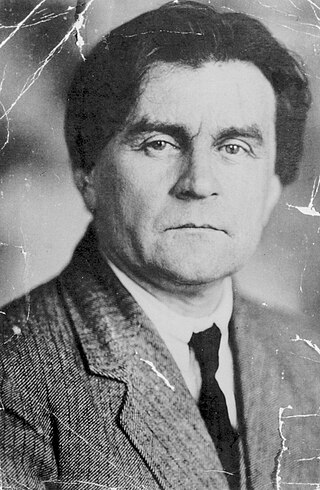
Kazimir Severinovich Malevich was a Russian avant-garde artist and art theorist, whose pioneering work and writing influenced the development of abstract art in the 20th century. He was born in Kiev, modern-day Ukraine, to an ethnic Polish family. His concept of Suprematism sought to develop a form of expression that moved as far as possible from the world of natural forms (objectivity) and subject matter in order to access "the supremacy of pure feeling" and spirituality. Active primarily in Russia, Malevich was a founder of the artists collective UNOVIS and his work has been variously associated with the Russian avant-garde and the Ukrainian avant-garde, and he was a central figure in the history of modern art in Central and Eastern Europe more broadly.

Suprematism is an early twentieth-century art movement focused on the fundamentals of geometry, painted in a limited range of colors. The term suprematism refers to an abstract art based upon "the supremacy of pure artistic feeling" rather than on visual depiction of objects.

Monochromatic painting has played a significant role in modern and contemporary Western visual art, originating with the early 20th-century European avant-gardes. Artists have explored the non-representational potential of a single color, investigating shifts in value, diversity of texture, and formal nuances as a means of emotional expression, visual investigation into the inherent properties of painting, as well as a starting point for conceptual works. Ranging from geometric abstraction in a variety of mediums to non-representational gestural painting, monochromatic works continue to be an important influence in contemporary art.
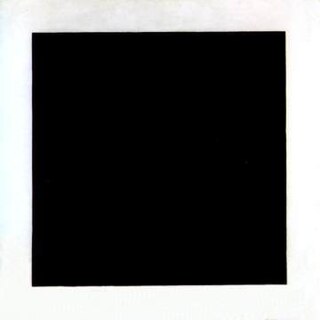
UNOVIS was a short-lived but influential group of artists, founded and led by Russian painter Kazimir Malevich at the Vitebsk Art School in 1919.

Cubo-Futurism was an art movement, developed within Russian Futurism, that arose in the early 20th-century Russian Empire, defined by its amalgamation of the artistic elements found in Italian Futurism and French Analytical Cubism. Cubo-Futurism was the main school of painting and sculpture practiced by the Russian Futurists. In 1913, the term "Cubo-Futurism" first came to describe works from members of the poetry group "Hylaeans", as they moved away from poetic Symbolism towards Futurism and zaum, the experimental "visual and sound poetry of Kruchenykh and Khlebninkov". Later in the same year the concept and style of "Cubo-Futurism" became synonymous with the works of artists within Ukrainian and Russian post-revolutionary avant-garde circles as they interrogated non-representational art through the fragmentation and displacement of traditional forms, lines, viewpoints, colours, and textures within their pieces. The impact of Cubo-Futurism was then felt within performance art societies, with Cubo-Futurist painters and poets collaborating on theatre, cinema, and ballet pieces that aimed to break theatre conventions through the use of nonsensical zaum poetry, emphasis on improvisation, and the encouragement of audience participation.
Supremus was a group of Russian avant-garde artists led by the "father" of Suprematism, Kazimir Malevich. It has been described as the first attempt to found the Russian avant-garde movement as an artistic entity within its own historical development.
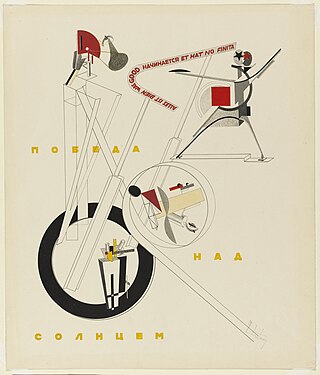
Victory over the Sun is a Russian Futurist opera premiered in 1913 at the Luna Park in Saint Petersburg.
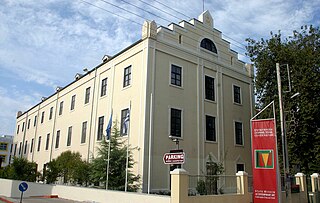
MOMus Modern, in full MOMus–Museum of Modern Art–Costakis Collection, is a modern art museum based in Thessaloniki, Central Macedonia, Greece. It is housed in the renovated building of the old Lazariston Monastery in the Borough of Stavroupoli in west Thessaloniki. It was formerly known as the State Museum of Contemporary Art.

Michael Vasilyevich Matyushin was a Russian painter and composer, leading member of the Russian avant-garde.
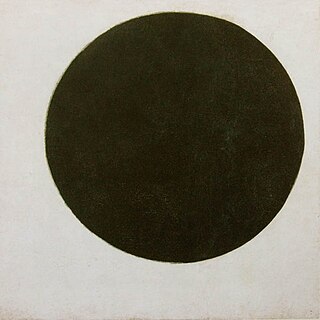
Black Circle is a 1924 oil-on-canvas painting by the Kyiv-born Russian artist Kazimir Malevich, founder of the Suprematism movement. From the mid-1910s, Malevich abandoned any trace of figurature or representation from his paintings in favour of pure abstraction.

Suprematist Composition: White on White (1918) is an abstract oil-on-canvas painting by Kazimir Malevich. It is one of the more well-known examples of the Russian Suprematism movement, painted the year after the October Revolution.

The Last Futurist Exhibition of Paintings 0,10 was an exhibition presented by the Dobychina Art Bureau at Marsovo Pole, Petrograd, from 19 December 1915 to 17 January 1916. The exhibition was important in inaugurating a form of non-objective art called Suprematism, introducing a daring visual vernacular composed of geometric forms of varying colour, and in signifying the end of Russia's previous leading art movement, Cubo-Futurism, hence the exhibition's full name. The sort of geometric abstraction relating to Suprematism was distinct in the apparent kinetic motion and angular shapes of its elements.
Nikolai Ivanovich Khardzhiev was a Ukrainian writer, literary and art collector. He possessed an extensive archive and collection of Russian Avantgarde art and literature.

Matthew Joseph Williams Drutt is an American curator and writer who specializes in modern and contemporary art and design. Based in New York, he has owned and operated his independent consulting practice Drutt Creative Arts Management (DCAM) since 2013. He is currently working with the Lee Ufan Foundation in Arles on an exhibition of non-objective art for Fall 2024. More recently, he worked with the Nationalmuseum Stockholm on an exhibition and publication of modern and contemporary American crafts gifted from artists and collectors in the United States to the museum, originally organized by his mother, Helen Drutt. He has worked more recently with the Eckbo Foundation in Oslo on the first major monograph of Thorwald Hellesen published in English and Norwegian in by Arnoldsche Art Publishers. He is currently also developing several other titles with the publisher. Formerly, he worked with the Beyeler Foundation in Switzerland (2013–2016) and the State Hermitage Museum in Russia (2013–2014), consulting on exhibitions, publications, and collections. He continues to serve as an Advisory Curator to the Hermitage Museum Foundation Israel. In 2006, the French Government awarded him the Chevalier de l'Ordre des Arts et des Lettres, and in 2003, his exhibition Kazimir Malevich: Suprematism won Best Monographic Exhibition Organized Nationally from the International Association of Art Critics.

Painterly Realism of a Peasant Woman in Two Dimensions, also known as Red Square, is a 1915 painting by Kazimir Malevich. Red Square was part of Malevich's Suprematist art movement (1915-1919), which aimed to create artworks that were universally understood.

The Knifegrinder or Principle of Glittering (Russian: Точильщик, Tochil'schik Printsip Mel'kaniia), also called The Knifegrinder (The Glittering Edge) and sometimes shortened to simply The Knifegrinder, is a 1912-13 cubo-futurist painting by the artist Kazimir Malevich, hence the fragmentation of form associated with futurism as well as the abstract geometry related to cubism. As of 2014, it is in the collection of the Yale University Art Gallery in New Haven, Connecticut.
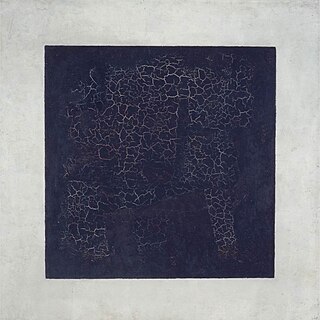
Black Square is a 1915 oil on linen canvas painting by the Russian avant-garde artist and theorist Kazimir Malevich. There are four painted versions, the first of which was completed in 1915 and described by the artist as his breakthrough work and the inception of his Suprematist art movement (1915–1919).
Album primo-avrilesque is a monograph by French writer, artist and humourist Alphonse Allais. The slim volume of 26 octavo landscape pages, 18.5 by 12 centimetres, bound with card, was published by Paul Ollendorff in Paris on 1 April 1897, and was sold for one franc. The work is generally known by its French title, which may be translated into English as "April Fool-ish album".

Caoutchouc is a painting created circa 1909 by the French artist Francis Picabia. At the crossroads of Cubism and Fauvism, Caoutchouc is considered one of the first abstract works in Western painting. The painting is in the collection of Centre Pompidou, Musée National d'Art Moderne, in Paris.

Secret Painting is a series of artworks created by British conceptual artist Mel Ramsden for the collective Art & Language between 1967 and 1968. The series consists of monochrome paintings juxtaposed with text panels explaining the absence of a conventional subject; for example, one states that the painting in question is invisible.
















